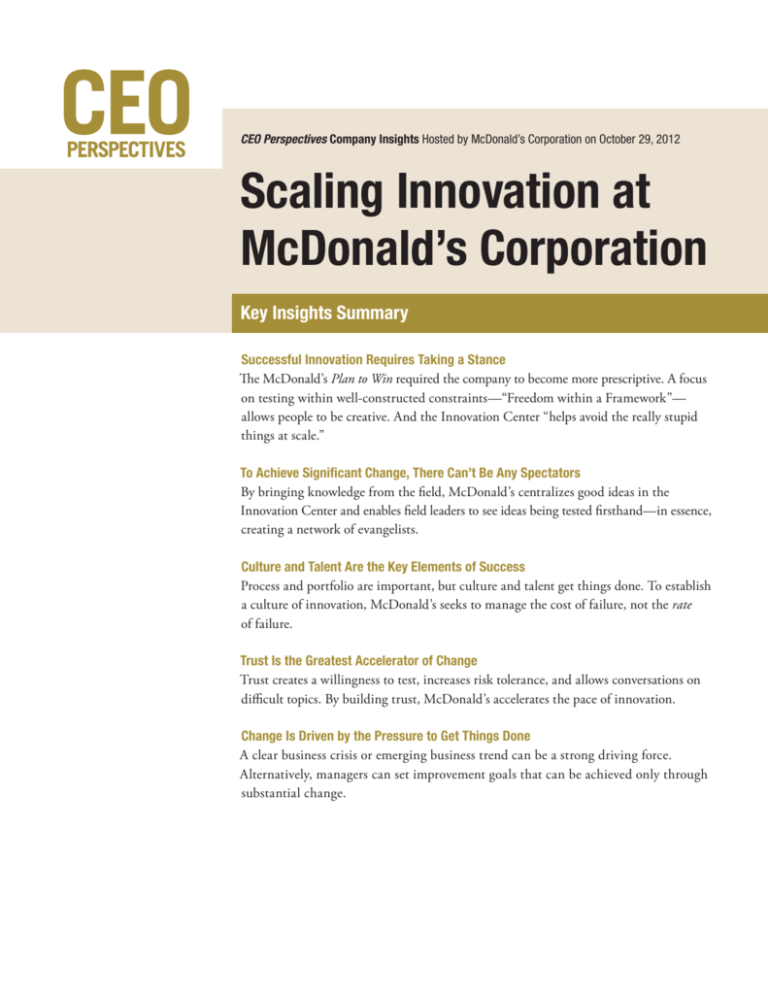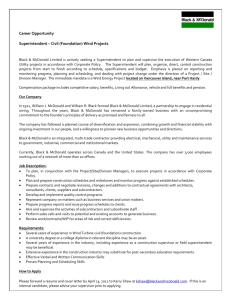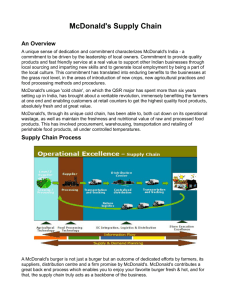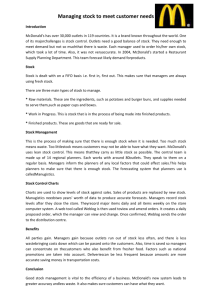
CEO Perspectives Company Insights Hosted by McDonald’s Corporation on October 29, 2012
Scaling Innovation at
McDonald’s Corporation
Key Insights Summary
Successful Innovation Requires Taking a Stance
The McDonald’s Plan to Win required the company to become more prescriptive. A focus
on testing within well-constructed constraints—“Freedom within a Framework”—
allows people to be creative. And the Innovation Center “helps avoid the really stupid
things at scale.”
To Achieve Significant Change, There Can’t Be Any Spectators
By bringing knowledge from the field, McDonald’s centralizes good ideas in the
Innovation Center and enables field leaders to see ideas being tested firsthand—in essence,
creating a network of evangelists.
Culture and Talent Are the Key Elements of Success
Process and portfolio are important, but culture and talent get things done. To establish
a culture of innovation, McDonald’s seeks to manage the cost of failure, not the rate
of failure.
Trust Is the Greatest Accelerator of Change
Trust creates a willingness to test, increases risk tolerance, and allows conversations on
difficult topics. By building trust, McDonald’s accelerates the pace of innovation.
Change Is Driven by the Pressure to Get Things Done
A clear business crisis or emerging business trend can be a strong driving force.
Alternatively, managers can set improvement goals that can be achieved only through
substantial change.
Scaling Innovation at McDonald’s Corporation Key Insights Summary
McDonald’s Highlights
The event focused on various aspects of the
McDonald’s innovation and scaling system—
including corporate strategy, menu innovation, and
operations testing and scaling. The chart below
shows how McDonald’s innovates across different
dimensions. While the best ideas typically come
from the field, the Innovation Center tests and
analyzes all menu items, décor, equipment, processes, and technologies before they are rolled out to
restaurants.
McDonald’s corporate strategy aims to foster
innovation, not necessarily drive it. The Plan to Win
galvanized 1.7 million employees around a core
set of ideas, principles, goals, and metrics, as well as
boundaries within which to innovate. Each market
has its own Plan to Win linked to the global Plan
To Win, which lays out corporate goals but doesn’t
specify how or where to innovate.
McDonald’s finds that some menu ideas can be
scaled to global markets, but others appeal only to
specific countries. Introducing new offerings to
2
33,500 restaurants requires orchestration and standards.
For instance, it can take years to create an assured
supply chain at scale. The lead market transfers knowledge to the global team at the Innovation Center,
which communicates it to other markets. This
continuous improvement loop refines the process as
it moves from market to market.
Field leaders who come to the Innovation Center
gain a real experience of the pipeline, which helps
them imagine how ideas might apply to their
situation. This approach promotes long-term thinking
about how individual markets can address their
needs with ideas in the pipeline. On the kitchen floor
of the Innovation Center, McDonald’s conducts
real-world tests to match the actual restaurants where
the innovation will be implemented.
Overall, McDonald’s has a strong focus on process
and people. When referring to a specific innovation,
the presenters and their materials almost always
mentioned the name of the original champion. This
emphasis reinforces McDonald’s culture and
celebrates individuals and their role in innovation.
Tracking innovation across different dimensions
Product
Place
People
Menu
Restaurant
design
Operating
platform
Technology
Innovation model
Market led
Area of world led
Center led
Center led
Operations model
Decentralized
Balanced
Center
Balanced
Responsibility
Chief Marketing
Officer
Chief Restaurant
Officer
Chief Restaurant
Officer
Chief Financial
Officer
Source: McDonald’s
Scaling Innovation at McDonald’s Corporation Key Insights Summary
Additional Insights from a
Cross-Industry Panel of Experts
Panelists: Jean Gilles, SVP, Deere & Company;
Roger Hochschild, President and COO, Discover
Financial Services; and Jeff Stratton, EVP and
Worldwide Chief Restaurant Officer, McDonald’s
Corporation. Moderator: Rob Wolcott, Professor of
Entrepreneurship & Innovation, Kellogg School of
Management.
General Observations
Jean: We spend a lot of time at Deere thinking
about products and solutions. We have a gathering
that we call a “Parts Expo” aimed at supporting
our network of dealerships in their pursuit of the parts
business. What I saw here today at McDonald’s
convinces me that we are doing it well—and could
do it even better. In particular, I was impressed
by how McDonald’s connects corporate strategy to
the goals and plans of small units.
Roger: About a year ago, the Discover board of
directors charged me with figuring out how to
improve innovation. Today, I saw great examples of
how necessity is the mother of innovation. A lot
About the
Event
3
of menu ideas come from Australia. It’s not that they
are more creative; it’s largely because McDonald’s
has such a large market share there. Since they need
to meet the same growth targets, they have to come
up with great thinking on offerings. A lot of cooking
equipment ideas come from Japan: due to real estate
constraints there, their kitchens are small so they have
to use space efficiently. Discover has focused on
innovation around accounts, with a focus on rewards.
But that approach won’t take us to the next level,
so we are exploring new paths to innovation.
How do you cultivate a culture where you can try
innovative ideas?
Jeff: One of the things we had to do was change the
talent early on. We needed world-class talent working
on some of our operating systems, our processes
and platforms. And we had talent that we were not
utilizing well. So bringing talent forward was the
first step. Then we decided that we wanted to be a
world-class innovation company. But first we had
to be world class in execution so that we could scale
and create value. That required taking a stance on
some things and becoming more prescriptive.
In the nine years that the Corporate Leadership Center has been running the CEO Perspectives program, more
than 180 Fellows have become alumni and nearly 60 companies and community organizations have sponsored senior
executives. Through this trusted network, executives learn and build important connections.
On October 29, 2012, the first-ever CEO Perspectives Company Insights event was held. The purpose of a postprogram event such as this is twofold: to generate ongoing access to relevant business and leadership insights
and to foster connections among the CEO Perspectives Fellows. This inaugural Company Insights event was designed
to provide an opportunity to delve into the wisdom and experience of the McDonald’s Corporation in scaling
innovation around the globe, across multiple platforms and stakeholders. CEO Perspectives intends to offer the
Company Insights events once or twice per year.
We are grateful to Don Thompson, Chief Executive Officer, and Jeff Stratton, Executive Vice President and Worldwide
Chief Restaurant Officer of McDonald’s Corporation, and their executive teams who hosted the event, which was
held at the McDonald’s Innovation Center in Romeoville, Illinois. The program featured remarks by key executives
involved in the innovation process at McDonald’s including corporate strategy, menu innovation, and operations
innovation; a tour of the facility’s full working test kitchens; and a panel to compare and contrast innovation
approaches at other companies such as Discover Financial Services and Deere & Company.
Scaling Innovation at McDonald’s Corporation Key Insights Summary
Jean: We are trying to create a culture where it’s
OK to fail small and early—“Bullets only, then a
cannon ball!” We have a history of innovation,
starting with our founder who built a plow that could
open the prairie, turning the Midwest into the
breadbasket of the world. It’s the first thing we tell
every employee. We became big coming out of
the 1980s, when things were very difficult in agriculture. We had leaders who had the guts to drive
new programs and to spend the time and effort to
deeply understand our customers.
Roger: When talking about innovation management,
you can look at process, talent, and culture. The last
two are the most important. It’s hard to create
a culture that tolerates failure. For us, it was easier to
create a culture where you’re expected to try new
things and distributing that across the organization.
We want it to be everyone’s job—not just product
development—to try three to four new things.
When a big idea at corporate is getting stuck, whom
do you hold accountable in a matrix organization to get
“the next big thing” done?
Roger: Discover doesn’t have anyone with a title
of innovation, instead going down the path of
encouraging innovation from everyone. By contrast,
one of our competitors set up a 300-person digital
innovation group away from headquarters. From what
I hear, everyone in the operating business hates
them and waits to kill the ideas coming out. You need
corporate resources to support innovation, but the
key is to have operating units with pressure to meet
tough goals in order to create a pull for corporate
Additional
Readings
innovation resources, versus trying to push things
out from corporate. Also, a lot of innovation can be
driven by developing partnerships with innovative
companies and aligning incentives. It’s a challenge to
build a PayPal culture in our regulated industry.
But such partners can influence how we think.
Jean: We do have someone with innovation in
his title. We expect him to help lead the structure
in which we do our advance work. But a lot of
innovation comes directly from the market. We
develop a strategy road map for technology development, bringing together people from the businesses
to share how they see the world and where things
appear to be heading. Then we work on creating
options. When it’s time for product development and
execution, the business units run the program.
In earlier stages, some innovation projects must be
separated in order to not die. The innovation group
opens minds and provides a framework for the future.
Closing Comment
Rob: Joseph Schumpeter, who invented the modern
notion of innovation economics, made a prediction
in the 1940s that is often dismissed: large organizations have the innovation advantage. There are a lot
of data points to suggest he’s wrong. But there are
also an increasing number that support his view. He
believed that large companies have the ability to
usurp ideas—sometimes come up with them on their
own—and then test, scale, and build portfolios
on a repeated basis to create significantly advantaged
success. I think over the next 10 or 20 years we
are going to see that prediction come to fruition.
“Cracking the Code of Innovation,” Forbes, August 19, 2003
“How to Bring Innovations to Market,” strategy + business, January 14, 2011
“Scaling Innovation Initiatives,” strategy + business, forthcoming
Copyright © 2013. Corporate Leadership Center. All rights reserved.
4








